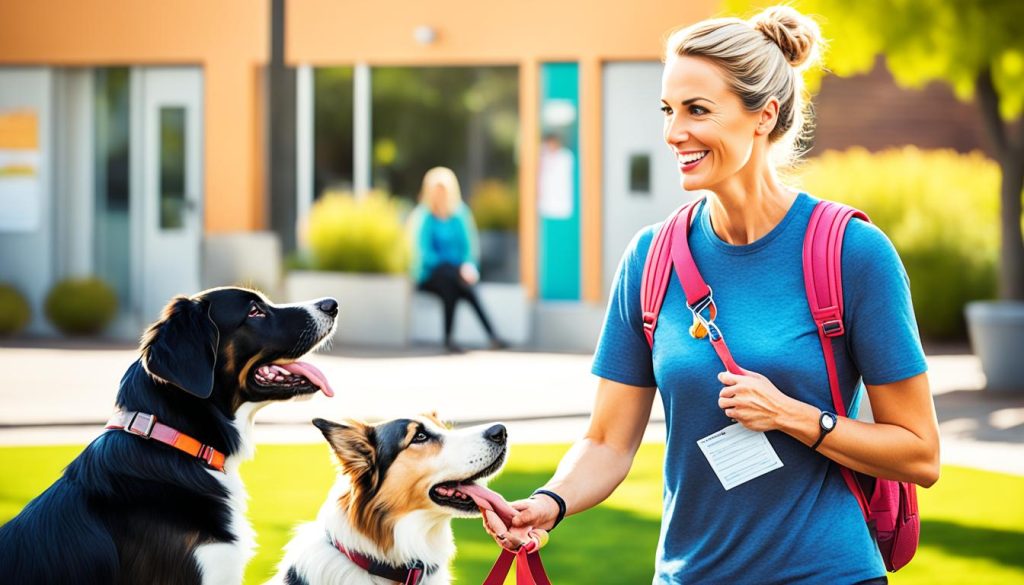If you’re a dog lover looking to turn your passion into a business, starting a dog walking business in the UK could be the perfect venture for you. With the rise in pet ownership and the busy lifestyles of many dog owners, the demand for professional dog walkers is on the rise. But how do you go about starting your own dog walking business and turning it into a successful enterprise?
In this guide, we’ll take you through everything you need to know about starting a dog walking business in the UK. From understanding the legal requirements and getting the right insurance to marketing your services and building a loyal customer base, we’ll cover all the essential steps to help you get your business up and running. So, grab your lead and let’s start exploring how to turn your love of dogs into a rewarding business opportunity.
Is Starting a Dog Walking Business Profitable?
The dog walking industry in the UK presents a lucrative opportunity for individuals who offer reliable and high-quality services. With the increasing pet ownership in the country, the demand for dog walking services is on the rise. As a dog walker, you have the potential to earn a substantial income while enjoying the companionship of furry friends.
On average, dog walkers in the UK earn between £10 to £20 per hour. However, several factors can influence your income potential:
- Location: The demand for dog walking services varies based on geographical location. Urban areas with higher pet populations and busy pet owners typically offer more business opportunities.
- Competition: The level of competition in your area can impact your pricing and ability to secure clients.
- Number of dogs walked at once: Walking multiple dogs simultaneously can increase your earning potential, as long as you can handle them safely and provide individual attention.
- Number of hours worked: The more hours you dedicate to dog walking, the greater your income potential. However, it’s important to strike a balance and avoid overexertion.
Additionally, offering additional services such as dog sitting or grooming can contribute to your revenue stream. By diversifying your services, you can cater to a wider range of pet owners’ needs and increase your income potential.
While the dog walking business can be profitable, it’s crucial to manage costs effectively to ensure long-term profitability. Consider the following expenses:
- Insurance: Protecting yourself and the dogs in your care is essential. Investing in insurance coverage, such as public liability insurance and animal accidents and injury insurance, will provide peace of mind and financial protection.
- Marketing: Promoting your dog walking business and attracting clients requires strategic marketing efforts. Allocate a budget for advertising, creating a professional website, printing flyers, and utilizing social media platforms.
- Equipment: Walking multiple dogs efficiently requires proper equipment, such as leashes, collars, waste bags, and perhaps even a vehicle for transportation.
By managing your costs and consistently delivering exceptional services, you can ensure profitability in your dog walking business.
Income Potential Comparison for Dog Walkers in the UK
| Location | Average Hourly Rate (£) |
|---|---|
| London | £15-£20 |
| Urban Areas | £12-£18 |
| Rural Areas | £10-£15 |
Based on location, the average hourly rates for dog walkers in the UK may vary. London tends to have higher rates due to the higher cost of living and increased demand for services. Urban areas generally offer competitive rates, while rural areas may have lower rates due to lower demand and fewer potential clients.
It’s important to research the dog walking market in your specific location and consider the demand, competition, and average rates to determine your pricing strategy.
By providing top-notch services, marketing effectively, and managing your costs, you can establish a profitable and successful dog walking business in the UK.

How to Start a Dog Walking Business?
To successfully start a dog walking business in the UK, it’s crucial to follow these essential steps:
- Gain Experience: Start by gaining experience and developing a good understanding of handling dogs. Consider volunteering at a local animal shelter or offering your services for free to friends and family to build your experience.
- Obtain Qualifications and Certifications: Enhance your credibility by obtaining necessary qualifications and certifications, such as pet first aid and dog handling courses.
- Comply with the Law: Ensure compliance with relevant laws by registering with HMRC, keeping records, and understanding canine laws such as dog control, wearing collars, and protecting livestock.
- Determine Walking Capacity: Determine the number of dogs you can walk at once based on factors such as location, regulations, and your ability to provide individual attention and control.
- Consider Costs: Take into account the costs involved in starting your business, including membership fees for associations like NARPs, DBS checks, insurance, marketing materials, and other expenses.
- Define Terms of Service: Clearly define your terms of service, including days of operation, breeds you will walk, walk duration, and pricing.
- Build a Strong Brand: Stand out from the competition by conducting market research and developing a unique selling proposition that appeals to your target audience.
- Promote Your Business: Use various channels like word of mouth, advertisements, flyers, and social media to generate awareness and attract clients.
Example Certification Courses:
If you’re looking to enhance your credentials, consider enrolling in the following certification courses:
| Certification Course | Description |
|---|---|
| Pet First Aid | Learn essential first aid techniques to handle emergencies and ensure the safety and well-being of dogs in your care. |
| Dog Handling and Control | Gain valuable skills in managing different dog temperaments, handling multiple dogs at once, and maintaining control in various situations. |

By following these steps and investing in your skills and knowledge, you’ll be well-prepared to launch a successful dog walking business in the UK.
Skills and Requirements for a Successful Dog Walking Business
While formal qualifications are not mandatory, certain skills and requirements are essential for a successful dog walking business. Experience with dogs is a must, as well as understanding canine behaviour and management. Handling multiple dogs at once requires expertise in managing different temperaments and sizes. Good communication skills are necessary to build trust with clients and ensure their peace of mind.
Basic business skills, such as organizing finances, setting up a website, and maintaining financial records, are important for running a dog walking business. Trustworthiness and the ability to provide transparency, reliability, and commitment are crucial for attracting clients.
Having the right paperwork and contracts in place, including service contracts, veterinary release forms, and key release forms, helps protect both you and your clients. Joining a national association like NARPsUK can bring credibility to your business and provide support through training courses, forms, and affordable insurance.
Skills and Requirements Summary:
- Experience with dogs and understanding canine behaviour
- Expertise in handling multiple dogs with different temperaments and sizes
- Good communication skills
- Basic business skills for financial management and website setup
- Trustworthiness, transparency, reliability, and commitment
- Proper paperwork and contracts, including service contracts, veterinary release forms, and key release forms
- Membership in a national association like NARPsUK for credibility and support
| Skills and Requirements | Details |
|---|---|
| Experience with dogs and understanding canine behaviour | Hands-on experience with dogs and knowledge of their behaviour, body language, and social interactions. |
| Expertise in handling multiple dogs with different temperaments and sizes | Ability to manage and control multiple dogs simultaneously, considering their unique temperaments and sizes. |
| Good communication skills | Effective communication with clients to understand their needs and convey important information. Clear communication with dogs using verbal cues and body language. |
| Basic business skills for financial management and website setup | Understanding of business fundamentals, including budgeting, accounting, and website development. Ability to organize finances, maintain financial records, and market your dog walking business. |
| Trustworthiness, transparency, reliability, and commitment | Being reliable, punctual, and committed to providing excellent service. Building trust with clients by demonstrating transparency in operations and maintaining a high level of professionalism. |
| Proper paperwork and contracts, including service contracts, veterinary release forms, and key release forms | Ensuring legal compliance and protecting both you and your clients. Having well-drafted service contracts, veterinary release forms, and key release forms to outline responsibilities and liabilities. |
| Membership in a national association like NARPsUK for credibility and support | Joining a reputable association like NARPsUK to enhance credibility, gain access to training courses, industry updates, and affordable insurance options. |

Conclusion
Starting a dog walking business in the UK can be a rewarding venture for passionate dog lovers. With the growing demand for dog walking services, it’s important to conduct thorough market research to identify your target audience and understand their needs. By implementing effective marketing strategies, you can attract clients and establish a reputable brand.
One of the most powerful marketing tools is word of mouth. Encourage satisfied clients to refer your services to their friends and family, and consider offering incentives or discounts for referrals. Additionally, investing in online and offline advertisements can help raise awareness of your business. Consider placing advertisements in local newspapers or pet-related magazines, as well as utilizing social media platforms to reach a wider audience.
Another effective marketing strategy is distributing flyers in areas where dog owners are likely to be found, such as parks, veterinary clinics, and pet stores. Ensure your flyers are well-designed, informative, and capture the attention of potential clients. Additionally, create a professional website that showcases your services, provides contact information, and includes testimonials from satisfied customers.
To further establish your business, consider partnering with local pet-related businesses, such as grooming salons or pet supply stores. This can help you tap into their customer base and gain additional exposure. Lastly, participate in dog-related events and community activities to network with fellow dog lovers and potential clients.





